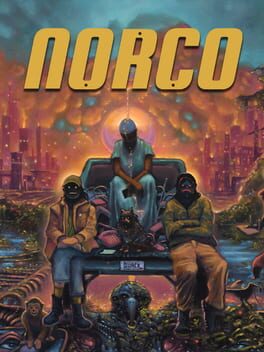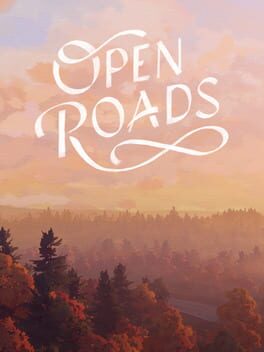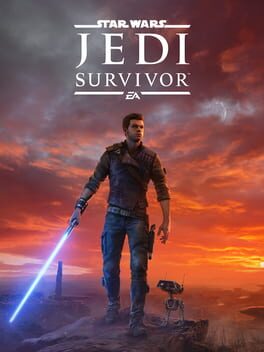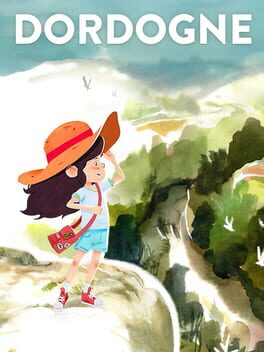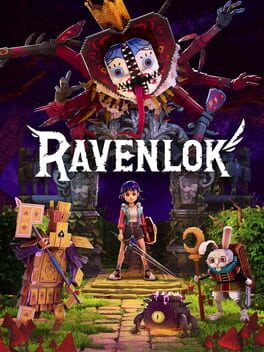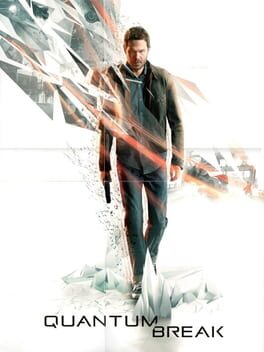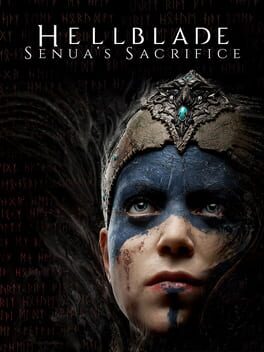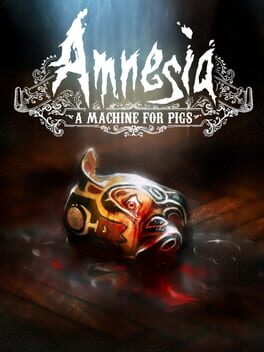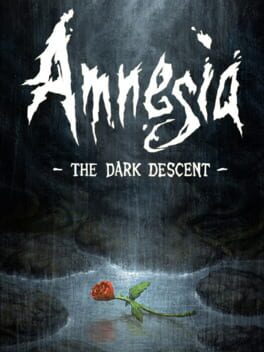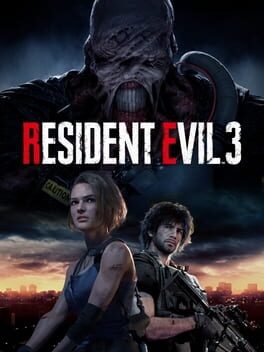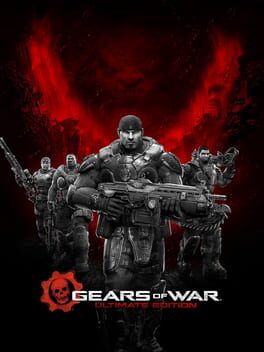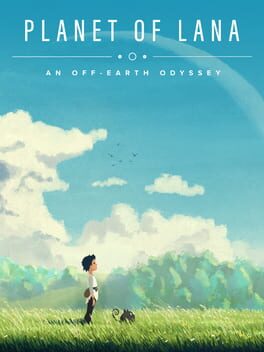szymon
2022
Type of experience that I appreciated more than I actually enjoyed. “Norco” is a visual novel with walls of text to get through and very little interactability, most instances of which are pretty underwhelming anyway, with the most irritating example being the combat which the game could’ve very well done without.
The environments and the writing do an excellent job of bringing to life this God-forgotten (?) town in Louisiana, with its unique sci-fi flavor and really dark humor. But as the story goes along, the game shifts its focus to plotlines/themes that I found to be some of the least interesting ones presented in the game and with each passing hour (out of roughly 7 it took me to finish the game) I kept losing interest and watching, sometimes in disbelief, the direction the writers decided to take. I can totally imagine an alternate “Norco” set in the same universe, utilizing many of the same levels, including many of the same plot points and NPCs (many of them are really fun to talk to) and overall themes (finding faith, impact of automatization on job opportunities, environmental externalities, the growing chasm between the haves and the have nots) but utilized in a more efficient way that doesn’t lose its focus in a major way.
The environments and the writing do an excellent job of bringing to life this God-forgotten (?) town in Louisiana, with its unique sci-fi flavor and really dark humor. But as the story goes along, the game shifts its focus to plotlines/themes that I found to be some of the least interesting ones presented in the game and with each passing hour (out of roughly 7 it took me to finish the game) I kept losing interest and watching, sometimes in disbelief, the direction the writers decided to take. I can totally imagine an alternate “Norco” set in the same universe, utilizing many of the same levels, including many of the same plot points and NPCs (many of them are really fun to talk to) and overall themes (finding faith, impact of automatization on job opportunities, environmental externalities, the growing chasm between the haves and the have nots) but utilized in a more efficient way that doesn’t lose its focus in a major way.
2024
My biggest gripe with the game is its artstyle - the combination of hand-drawn character models with environments and interactable objects that might as well be taken straight from the Unity Asset Store felt off and I wish the developers had come up with a better way to combine the early 2000’s nostalgia evoking cartoons and the plain, ubiquitous 3D assets. Other than that, I was left quite satisfied with ‘Open Roads’ - for most of its 3 hour ‘runtime’ I felt almost as if I was watching a Sundance indie movie. The mystery at the center of the plot isn’t particularly high stakes, but it doesn’t need to be - it provides a good excuse for a mother-daughter road trip where they can bond and learn more about each other. The dialogue is mostly well-written and the two voice actresses work really well together.
I spent about 15 hours with the game, and looking at walkthroughs I’m guessing I made it about halfway through the main questline with a bunch of extra exploration sprinkled here and there.
I remember enjoying the first entry quite a bit, with its competent blend of light soulslike elements and Tomb Raider-like traversal through open environments that rewarded exploration. I don’t know what happened, perhaps my taste has shifted significantly, because playing ‘Survivor’ felt like a waste of time. This is the kind of game where you can point to almost each mechanic and tell which game it took it from. Same goes for the story - it’s the most cliched, uninspired Star Wars fluff you'd come to expect from the Disney era SW. The NPCs are usually nicely animated, they exchange quirky dialogue clearly inspired by the Marvel movies, the environments are vast with plenty of opportunity to explore (although the reward could be something more substantial than a new grip for the lightsaber or a new haircut for Cal). The combat usually works just fine and there is some variation in how you can utilize your weapons, which this time include a laser pistol. But it all just feels so bland, generic and safe that a couple of hours in I couldn’t bring myself to give a damn about any characters fighting, once again, against the evil Empire. I was forcing myself through the main story because I try not to abandon games, but this time the game simply wore me out.
One other thing I need to mention is the game’s technical state. I was playing on Series X and in performance mode the actual performance was far from perfect. Apart from losing frames regularly the backgrounds would often flicker, as if some objects would take too long to load when I was moving the camera around. There were some odd hitboxes here and there, at some points I wasn’t able to use the right stick to switch lock on between targets which I found particularly infuriating. Every time I’d wake the game with Quick Resume I’d have to wait a good 10-15 seconds for it to stop stuttering, and one hard crash made me lose quite a bit of progress. There are also tons of awkward animations, where Cal gets blocked on various objects.
I remember enjoying the first entry quite a bit, with its competent blend of light soulslike elements and Tomb Raider-like traversal through open environments that rewarded exploration. I don’t know what happened, perhaps my taste has shifted significantly, because playing ‘Survivor’ felt like a waste of time. This is the kind of game where you can point to almost each mechanic and tell which game it took it from. Same goes for the story - it’s the most cliched, uninspired Star Wars fluff you'd come to expect from the Disney era SW. The NPCs are usually nicely animated, they exchange quirky dialogue clearly inspired by the Marvel movies, the environments are vast with plenty of opportunity to explore (although the reward could be something more substantial than a new grip for the lightsaber or a new haircut for Cal). The combat usually works just fine and there is some variation in how you can utilize your weapons, which this time include a laser pistol. But it all just feels so bland, generic and safe that a couple of hours in I couldn’t bring myself to give a damn about any characters fighting, once again, against the evil Empire. I was forcing myself through the main story because I try not to abandon games, but this time the game simply wore me out.
One other thing I need to mention is the game’s technical state. I was playing on Series X and in performance mode the actual performance was far from perfect. Apart from losing frames regularly the backgrounds would often flicker, as if some objects would take too long to load when I was moving the camera around. There were some odd hitboxes here and there, at some points I wasn’t able to use the right stick to switch lock on between targets which I found particularly infuriating. Every time I’d wake the game with Quick Resume I’d have to wait a good 10-15 seconds for it to stop stuttering, and one hard crash made me lose quite a bit of progress. There are also tons of awkward animations, where Cal gets blocked on various objects.
2023
2023
I’m sad to report that outside of the graphics there is absolutely nothing interesting about “Ravenlok”. And for some it may be enough - the levels, the enemies, the NPCs are all well designed, very colorful and clearly drawing inspiration from the craziness of “Alice in Wonderland”. It’s very pleasant to look at and the environments are varied.
Those beautiful environments are populated by forgettable NPCs that spout out the most unimaginative lines about saving the kingdom and a bad witch, the plot throwing you from one level to another just because you need to reach the next macguffin, and a protagonist that lacks any characterization or opportunity to make any meaningful choices (you can level up your character and the menu resembles that of an RPG, but this is not at all a representative of the genre).
The combat - unlike in Cococucumber’s previous game, “Echo Generation” - is real-time, and feels very undercooked. There is one type of attack you can do with your sword plus 4 special attacks that you gain access to throughout the game. You can also dash and use your shield, however I don’t recall using the latter outside of the early training section. The simplicity of the combat systems makes fighting your enemies feel like a chore from early on, especially since the game seems to take great joy in throwing dozens of them at you regularly. It’s also fair to say the enemies aren’t too varied - you basically use the same tactic for all of the encounters, i.e. use your ‘specials’, dash around while waiting for them to be available again, repeat. There are a good number of boss fights that provide some desired change, but they’re usually too easy and the baddies go down on the first go without too much of a hassle. And yes, even on the highest difficulty the game is way too easy.
There are also some odd design choices regarding the combat system, e.g. there is a stamina bar that only gets depleted when you use the shield. When you attack, use your special attacks or dash around the stamina doesn’t seem to be affected at all, which takes away the necessity for strategizing your movements - think of the most obvious point of comparison, i.e. the soulslikes, where it’s an extremely important part of the game. It’s a shame, because otherwise it would’ve added some flavor and challenge to the combat which is rather plain and boring as it is. You also can’t lock on enemies, which is a nitpick, but I always like having this option in games with melee combat.
The game contains a handful of puzzles, most of them quite easy, which is a shame since had the developers put more emphasis on them at the cost of the combat sections, the game would’ve had a much better flow and the mediocrity of the combat could’ve stood out less. There are also some pretty poor stealth sections that try to break the monotony, but since there is no way to figure out the enemy’s visibility cone they prove more annoying rather than a meaningful way to expand the gameplay.
The quest design is lackluster as well. You’ll be mostly asked to slay X enemies, collect Y items or something of the like. The exploration is also rather limited, with the only real collectible being small rabbit figurines in front of which you need to dance. It’s neat, but I’d love more opportunities to explore these beautiful levels.
At the very end of the story you end up sitting at a table with the NPCs that you aided on your journey, and looking at them I started asking myself - who are these characters? The game fails to build any sense of investment in this world. With vapid writing and boring, unchallenging gameplay, you should only give this a shot if you really, really love voxel art.
Those beautiful environments are populated by forgettable NPCs that spout out the most unimaginative lines about saving the kingdom and a bad witch, the plot throwing you from one level to another just because you need to reach the next macguffin, and a protagonist that lacks any characterization or opportunity to make any meaningful choices (you can level up your character and the menu resembles that of an RPG, but this is not at all a representative of the genre).
The combat - unlike in Cococucumber’s previous game, “Echo Generation” - is real-time, and feels very undercooked. There is one type of attack you can do with your sword plus 4 special attacks that you gain access to throughout the game. You can also dash and use your shield, however I don’t recall using the latter outside of the early training section. The simplicity of the combat systems makes fighting your enemies feel like a chore from early on, especially since the game seems to take great joy in throwing dozens of them at you regularly. It’s also fair to say the enemies aren’t too varied - you basically use the same tactic for all of the encounters, i.e. use your ‘specials’, dash around while waiting for them to be available again, repeat. There are a good number of boss fights that provide some desired change, but they’re usually too easy and the baddies go down on the first go without too much of a hassle. And yes, even on the highest difficulty the game is way too easy.
There are also some odd design choices regarding the combat system, e.g. there is a stamina bar that only gets depleted when you use the shield. When you attack, use your special attacks or dash around the stamina doesn’t seem to be affected at all, which takes away the necessity for strategizing your movements - think of the most obvious point of comparison, i.e. the soulslikes, where it’s an extremely important part of the game. It’s a shame, because otherwise it would’ve added some flavor and challenge to the combat which is rather plain and boring as it is. You also can’t lock on enemies, which is a nitpick, but I always like having this option in games with melee combat.
The game contains a handful of puzzles, most of them quite easy, which is a shame since had the developers put more emphasis on them at the cost of the combat sections, the game would’ve had a much better flow and the mediocrity of the combat could’ve stood out less. There are also some pretty poor stealth sections that try to break the monotony, but since there is no way to figure out the enemy’s visibility cone they prove more annoying rather than a meaningful way to expand the gameplay.
The quest design is lackluster as well. You’ll be mostly asked to slay X enemies, collect Y items or something of the like. The exploration is also rather limited, with the only real collectible being small rabbit figurines in front of which you need to dance. It’s neat, but I’d love more opportunities to explore these beautiful levels.
At the very end of the story you end up sitting at a table with the NPCs that you aided on your journey, and looking at them I started asking myself - who are these characters? The game fails to build any sense of investment in this world. With vapid writing and boring, unchallenging gameplay, you should only give this a shot if you really, really love voxel art.
2016
TL;DR: This doesn’t feel like a Remedy game.
The experience is difficult from the very beginning - the initial 30 minutes or so are surprisingly sloppy. We’re dividing our attention between Jack dumping exposition regarding his brother and Paul, future Jack dumping exposition during his deposition, at the same time slowly walking around and gathering notes and memos to read more exposition, then following Paul and listening to him providing to us, you guessed it, more exposition. There’s even an actual PowerPoint presentation. This does not encourage players to jump into this world, quite the opposite. And the worst part is - all that exposition is in service of an extremely bland, uninteresting story.
I’ll be the first to admit that I don’t enjoy time traveling as a narrative concept. I think it’s inherently broken and writers often abuse various implications from characters being able to travel between different periods in time. And yeah, I couldn’t get into this story either, but I don’t think it’s fair to say it’s only due to my dislike of this particular genre. I couldn’t care less about the time travel machines, the implications of ‘ripples’, etc. mostly because the characters were not at all interesting. The game attempts to build this rivalry between Paul and Jack and does so sloppily. Whenever these two would face off I felt nothing, including the shockingly anticlimactic conclusion. Hatch rides on Reddick’s charisma and nothing else, Beth is kind of a wet blanket, and some other supporting characters like Liam, Charlie or Fiona (present almost exclusively in the show) mostly fall flat as well. The game wants you to believe that total annihilation is what’s at stake - that if Jack doesn’t succeed then ‘the end of times’ will take place. But this is such a vague and abstract concept that I couldn’t bring myself to give a shit about what happens to this world, also due to my not sympathizing with even a single character in the story.
Also, the game takes itself too seriously which makes the whole experience funnier, listening to cheesy lines about chronon fields, the end of time and whatnot uttered with straight faces. I’m pretty sure it would’ve worked better if the writers tried to lean into the cheesiness of the material they were working on.
Gameplay wise, it feels like squandered potential. Jack’s superpowers can be fun to use and even though they’re not overly original it feels good to slow down time, sprint between enemies and take them out one by one or to throw ‘time grenades’. However, in addition to those powers Jack is required to shoot his enemies down and I’m sad to report that the gunplay is simply unsatisfying. Most guns feel like peashooters with no punch, and some annoy with ridiculous recoil. I really wish Remedy had removed the ability to use firearms altogether and just focused on developing the time powers to make them the only available way to fight. Also, enemy design is just lazy.
The game doesn’t play great, but looks even worse. To be clear, I don’t mean the quality of the animations or character models - these all hold up well, although I’ll never believe that Aidan Gillen is below 30, even with that ridiculous glow up he’s given in the opening chapter. But ‘Quantum Break’ probably includes the most boring art direction I’ve seen in a AAA game. Every location is extremely bland, just a generic city with generic buildings and generic interiors. That includes even some areas where the creators could’ve potentially employed some more unusual concepts, like the time machine and all the relevant macguffins like weapons, armours, labs, etc. Instead, every little visual detail looks like something that’s been included in a dozen other games and shows with a similar minimalist, ‘clean’ aesthetic. Maybe it was done purposefully in order to be consistent with the show which looks equally bland, but I wish they’d showed some more creativity in that department regardless.
Another disappointing element was the level design. I struggle to recall any memorable set pieces or combat arenas or any of the like (there are some ‘platforming’ sections, but I’ll do the devs a favor and refrain from elaborating on those). Everything seemed very straightforward, with a couple of very simple puzzles thrown in to break up the monotony of the main gameplay loop. These aren’t too difficult also because the game uses its own version of ‘witcher vision’ (I just double checked and yes, it’s called ‘Time Vision’, Jesus Christ). So you don’t even need to think too much about what to do next, you just click a button and receive a solution instantly. I doubt I’m the only one who hates this mechanic as it makes the games just too easy and level designers too lazy (why bother directing the player through environmental clues? Just click a button to highlight all important parts, or spray the only available route among the rubble with yellow paint - there are many offenders in this area, this game naturally being one of them).
The time mechanic could’ve been used in a million ways to create some clever puzzles or obstacle courses for Jack to solve between shooting down Monarch guards. The only ones we’re given boil down to “hold Y to reverse time for a bit” and voila. It’s also infuriating how limiting the game is, e.g. only allowing you to climb specific objects that the devs wanted you to climb and whenever you want to get up an object of the same or even lower height, Jack just bumps off them. This is really detrimental to any attempt at building immersion.
One thing that I liked from the narrative standpoint was allowing you to make decisions as Paul. These then influence which of two episodes of the show you will see. It’s a neat idea and gives you some feeling of power over the story, but if I’m not mistaken it only changes things in the show - the game stays the same regardless of your choices, which is a bit disappointing.
A large part of the game’s marketing campaign was that Quantum Break was an experience combining a video game with an ‘equally important’ TV show. And yes, there are four short (around 22-24mins) episodes that delve more into the events behind the scenes and focusing mostly on characters not given significant time in (or absent at all from) the game. First of all - it’s very clear that the video game was the primary focus of the creators and the show is filling in gaps that otherwise would’ve been either included as cutscenes or as memos/e-mails/notes (boy, do Remedy love those). And I think it would’ve been fine, because the show’s production value is one of the lowest I’ve seen. It’s mostly actors walking around large, empty, cheap-looking sets and exchanging exposition. It’s a shame, because they clearly spent some money to get people like Aidan Gillen or Lance Reddick, but even their charisma can’t save this vapid, sometimes straight up dumb script. The inclusion of the poorly made TV show makes the whole experience feel cheaper and cheesier than if the information from the show was given to the player using in-game methods.
The game clearly wanted to be a blockbuster - a high budget story with high stakes and some recognizable faces playing the main characters. But the whole experience is so bland and uninteresting it’s almost hard to believe that it was Remedy who was behind it. This doesn’t feel like a product of a developer with almost two decades of experience in groundbreaking storytelling. It feels like a copout, a safe, focus group-driven product delivered to a major publisher who was in his TV era (yes, Xbox, we remember) and needed a showcase for the ideas behind his newest toy.
I also encountered some problems in the technical department, like how is this game locked at 30fps in such a low resolution on Series X? Many cutscenes included some odd stutters. Also, the episodes aren’t available to stream anymore which is disappointing - I had to watch them in pisspoor quality on Youtube. There was one cutscene that anytime I wanted to skip it would just crash the game. One little detail I also need to mention - this one time when Jack was talking on the phone I zoomed in to see whether I could see the phone screen. I could and I only saw the menu - why are you pretending to be on the phone, Jack?!
So yeah, it’s a skip.
The experience is difficult from the very beginning - the initial 30 minutes or so are surprisingly sloppy. We’re dividing our attention between Jack dumping exposition regarding his brother and Paul, future Jack dumping exposition during his deposition, at the same time slowly walking around and gathering notes and memos to read more exposition, then following Paul and listening to him providing to us, you guessed it, more exposition. There’s even an actual PowerPoint presentation. This does not encourage players to jump into this world, quite the opposite. And the worst part is - all that exposition is in service of an extremely bland, uninteresting story.
I’ll be the first to admit that I don’t enjoy time traveling as a narrative concept. I think it’s inherently broken and writers often abuse various implications from characters being able to travel between different periods in time. And yeah, I couldn’t get into this story either, but I don’t think it’s fair to say it’s only due to my dislike of this particular genre. I couldn’t care less about the time travel machines, the implications of ‘ripples’, etc. mostly because the characters were not at all interesting. The game attempts to build this rivalry between Paul and Jack and does so sloppily. Whenever these two would face off I felt nothing, including the shockingly anticlimactic conclusion. Hatch rides on Reddick’s charisma and nothing else, Beth is kind of a wet blanket, and some other supporting characters like Liam, Charlie or Fiona (present almost exclusively in the show) mostly fall flat as well. The game wants you to believe that total annihilation is what’s at stake - that if Jack doesn’t succeed then ‘the end of times’ will take place. But this is such a vague and abstract concept that I couldn’t bring myself to give a shit about what happens to this world, also due to my not sympathizing with even a single character in the story.
Also, the game takes itself too seriously which makes the whole experience funnier, listening to cheesy lines about chronon fields, the end of time and whatnot uttered with straight faces. I’m pretty sure it would’ve worked better if the writers tried to lean into the cheesiness of the material they were working on.
Gameplay wise, it feels like squandered potential. Jack’s superpowers can be fun to use and even though they’re not overly original it feels good to slow down time, sprint between enemies and take them out one by one or to throw ‘time grenades’. However, in addition to those powers Jack is required to shoot his enemies down and I’m sad to report that the gunplay is simply unsatisfying. Most guns feel like peashooters with no punch, and some annoy with ridiculous recoil. I really wish Remedy had removed the ability to use firearms altogether and just focused on developing the time powers to make them the only available way to fight. Also, enemy design is just lazy.
The game doesn’t play great, but looks even worse. To be clear, I don’t mean the quality of the animations or character models - these all hold up well, although I’ll never believe that Aidan Gillen is below 30, even with that ridiculous glow up he’s given in the opening chapter. But ‘Quantum Break’ probably includes the most boring art direction I’ve seen in a AAA game. Every location is extremely bland, just a generic city with generic buildings and generic interiors. That includes even some areas where the creators could’ve potentially employed some more unusual concepts, like the time machine and all the relevant macguffins like weapons, armours, labs, etc. Instead, every little visual detail looks like something that’s been included in a dozen other games and shows with a similar minimalist, ‘clean’ aesthetic. Maybe it was done purposefully in order to be consistent with the show which looks equally bland, but I wish they’d showed some more creativity in that department regardless.
Another disappointing element was the level design. I struggle to recall any memorable set pieces or combat arenas or any of the like (there are some ‘platforming’ sections, but I’ll do the devs a favor and refrain from elaborating on those). Everything seemed very straightforward, with a couple of very simple puzzles thrown in to break up the monotony of the main gameplay loop. These aren’t too difficult also because the game uses its own version of ‘witcher vision’ (I just double checked and yes, it’s called ‘Time Vision’, Jesus Christ). So you don’t even need to think too much about what to do next, you just click a button and receive a solution instantly. I doubt I’m the only one who hates this mechanic as it makes the games just too easy and level designers too lazy (why bother directing the player through environmental clues? Just click a button to highlight all important parts, or spray the only available route among the rubble with yellow paint - there are many offenders in this area, this game naturally being one of them).
The time mechanic could’ve been used in a million ways to create some clever puzzles or obstacle courses for Jack to solve between shooting down Monarch guards. The only ones we’re given boil down to “hold Y to reverse time for a bit” and voila. It’s also infuriating how limiting the game is, e.g. only allowing you to climb specific objects that the devs wanted you to climb and whenever you want to get up an object of the same or even lower height, Jack just bumps off them. This is really detrimental to any attempt at building immersion.
One thing that I liked from the narrative standpoint was allowing you to make decisions as Paul. These then influence which of two episodes of the show you will see. It’s a neat idea and gives you some feeling of power over the story, but if I’m not mistaken it only changes things in the show - the game stays the same regardless of your choices, which is a bit disappointing.
A large part of the game’s marketing campaign was that Quantum Break was an experience combining a video game with an ‘equally important’ TV show. And yes, there are four short (around 22-24mins) episodes that delve more into the events behind the scenes and focusing mostly on characters not given significant time in (or absent at all from) the game. First of all - it’s very clear that the video game was the primary focus of the creators and the show is filling in gaps that otherwise would’ve been either included as cutscenes or as memos/e-mails/notes (boy, do Remedy love those). And I think it would’ve been fine, because the show’s production value is one of the lowest I’ve seen. It’s mostly actors walking around large, empty, cheap-looking sets and exchanging exposition. It’s a shame, because they clearly spent some money to get people like Aidan Gillen or Lance Reddick, but even their charisma can’t save this vapid, sometimes straight up dumb script. The inclusion of the poorly made TV show makes the whole experience feel cheaper and cheesier than if the information from the show was given to the player using in-game methods.
The game clearly wanted to be a blockbuster - a high budget story with high stakes and some recognizable faces playing the main characters. But the whole experience is so bland and uninteresting it’s almost hard to believe that it was Remedy who was behind it. This doesn’t feel like a product of a developer with almost two decades of experience in groundbreaking storytelling. It feels like a copout, a safe, focus group-driven product delivered to a major publisher who was in his TV era (yes, Xbox, we remember) and needed a showcase for the ideas behind his newest toy.
I also encountered some problems in the technical department, like how is this game locked at 30fps in such a low resolution on Series X? Many cutscenes included some odd stutters. Also, the episodes aren’t available to stream anymore which is disappointing - I had to watch them in pisspoor quality on Youtube. There was one cutscene that anytime I wanted to skip it would just crash the game. One little detail I also need to mention - this one time when Jack was talking on the phone I zoomed in to see whether I could see the phone screen. I could and I only saw the menu - why are you pretending to be on the phone, Jack?!
So yeah, it’s a skip.
2023
Ahead of the upcoming release of the sequel, I decided to return to ‘Hellblade’ to refresh my memory and to be able to notice (and hopefully appreciate) all the changes included in ‘Senua’s Saga: Hellblade 2’.
The second playthrough didn’t change my general view of the game - it’s a must-play for anyone seeking a rich narrative experience with a couple of issues that hold the game back from being a true masterpiece.
The good stuff first - the game is built around a really interesting story that is told with maturity and boldness rarely seen in other games. Senua’s desperate, exhausting journey towards redemption and her gradual unlocking and analysis of past events to remove the shackles imposed by her upbringing is truly fascinating to watch. Dip all that in a healthy dose of Norse mythology, some top notch acting (Melina Juergens is a star) and you’ll end up with a truly special narrative experience. The game delves heavily into the topics of mental health and psychosis in particular, with one of its most advertised features being ‘voices in your head’ (first time in forever I played a console game with a headset, simply because it’s one of the few games where it enhances the experience significantly, even if sometimes those voices offer input on puzzle solutions too quickly). This helps tremendously in immersing yourself in the story and in sympathizing with Senua. The topic of ignorance of complex mental issues paired with religious zealotry is also an important part of the game. By the end of the story I felt truly proud of Senua, even if the final song was too cheesy and on the nose for my taste.
In a lot of ways the gameplay serves the narrative, with one of the most obvious examples being Senua searching for runes hidden in the environment. I think it’s a neat idea, however I did feel like the game relied too heavily on it - that also includes the mechanic of “look through gate to open path”, which appeared too many times for my liking.
The game breaks up the pace in a number of ways, e.g. when Senua needs to stealthily move amongst monsters made of pulsating flesh, running between sources of light to evade a ‘dragon’ or sprinting through a burning house. These are truly standout moments in the game.
A whole other thing is combat. I have a problem with it simply because I realize it was not intended to be “fun” - quite the opposite, actually. If these encounters symbolize Senua struggling to go on, her debilitating illness trying to stop her from continuing her quest, then fighting off the physical manifestations of it should be frustrating and difficult. However, I felt like the combat sections gave up on their narrative significance quite quickly and became simply a thing for the player to do (there are a few moments where it makes sense to have Senua fight off hordes of enemies, to be fair). Perhaps the developers were afraid that without them the game would be too akin to walking simulators and written off by many players disliking that particular genre. I, for one, wouldn’t mind being challenged in other ways (e.g. through more complex puzzles) to emphasize Senua’s struggles. The combat itself is pretty run of the mill, with camera being often detrimental when fighting several enemies at once. Same with switching targets - I don’t think the combat system was well designed to accommodate more than 1-2 opponents at once. Also - please, include an option to sprint next time, in some larger areas it took forever to get between points of interest.
The second playthrough didn’t change my general view of the game - it’s a must-play for anyone seeking a rich narrative experience with a couple of issues that hold the game back from being a true masterpiece.
The good stuff first - the game is built around a really interesting story that is told with maturity and boldness rarely seen in other games. Senua’s desperate, exhausting journey towards redemption and her gradual unlocking and analysis of past events to remove the shackles imposed by her upbringing is truly fascinating to watch. Dip all that in a healthy dose of Norse mythology, some top notch acting (Melina Juergens is a star) and you’ll end up with a truly special narrative experience. The game delves heavily into the topics of mental health and psychosis in particular, with one of its most advertised features being ‘voices in your head’ (first time in forever I played a console game with a headset, simply because it’s one of the few games where it enhances the experience significantly, even if sometimes those voices offer input on puzzle solutions too quickly). This helps tremendously in immersing yourself in the story and in sympathizing with Senua. The topic of ignorance of complex mental issues paired with religious zealotry is also an important part of the game. By the end of the story I felt truly proud of Senua, even if the final song was too cheesy and on the nose for my taste.
In a lot of ways the gameplay serves the narrative, with one of the most obvious examples being Senua searching for runes hidden in the environment. I think it’s a neat idea, however I did feel like the game relied too heavily on it - that also includes the mechanic of “look through gate to open path”, which appeared too many times for my liking.
The game breaks up the pace in a number of ways, e.g. when Senua needs to stealthily move amongst monsters made of pulsating flesh, running between sources of light to evade a ‘dragon’ or sprinting through a burning house. These are truly standout moments in the game.
A whole other thing is combat. I have a problem with it simply because I realize it was not intended to be “fun” - quite the opposite, actually. If these encounters symbolize Senua struggling to go on, her debilitating illness trying to stop her from continuing her quest, then fighting off the physical manifestations of it should be frustrating and difficult. However, I felt like the combat sections gave up on their narrative significance quite quickly and became simply a thing for the player to do (there are a few moments where it makes sense to have Senua fight off hordes of enemies, to be fair). Perhaps the developers were afraid that without them the game would be too akin to walking simulators and written off by many players disliking that particular genre. I, for one, wouldn’t mind being challenged in other ways (e.g. through more complex puzzles) to emphasize Senua’s struggles. The combat itself is pretty run of the mill, with camera being often detrimental when fighting several enemies at once. Same with switching targets - I don’t think the combat system was well designed to accommodate more than 1-2 opponents at once. Also - please, include an option to sprint next time, in some larger areas it took forever to get between points of interest.
I realize that the second entry in the franchise has received a sort of reappraisal amongst Amnesia fans in recent years, but I’m afraid I can’t agree with their praise of the game. I still feel like it is a mere shadow of what its predecessor was able to achieve.
My main issue is that during my playthrough it felt like I was sprinting through the game. Unlike the original entry in the franchise, there are hardly any puzzles (going to two different corners in a level and rotating valves does not count as a puzzle) that will make you stop and think on your next move. The levels are streamlined, which kills the necessity to roam around a maze-like environment, collecting necessary items to make it to the next part and at the same time watching out for enemies that can be lurking in any corner. There are dozens upon dozens of closed doors which make you feel like you’re being led by the devs rather than figuring out the right way on your own.
There is a lot less interactivity compared to ‘The Dark Descent’, where you were able to pick up most items. Here it feels more like you’re in a museum, and only allowed to touch objects absolutely necessary to make your way further. Even many drawers are permanently shut - why?
I appreciate the game taking its time to build tension and only introducing enemies after an hour or so, but when they do appear, they mostly show up in tight spaces where you’re forced to run around them before realizing they take forever to spot you and deal any real damage (which isn’t really an issue anyway, since your character regenerates health automatically). This kills any feeling of tension when traversing through levels, as enemies become a nuisance that can be ignored surprisingly often.
The part I liked best was its story, and I genuinely was curious to see what happens next to Mandus. I was quite satisfied with the ending, and witnessing the bedlam unfold on the streets of London was definitely a memorable sight. There are plenty of diary entries written by the protagonist that should allow players to sympathize with him more, although I feel like the writers had a greater opportunity to turn the events of the game into more of a social commentary (there are some nuggets hidden in some of the notes pointing to this), but in the end opted for a more standard horror story fitting the genre.
My main issue is that during my playthrough it felt like I was sprinting through the game. Unlike the original entry in the franchise, there are hardly any puzzles (going to two different corners in a level and rotating valves does not count as a puzzle) that will make you stop and think on your next move. The levels are streamlined, which kills the necessity to roam around a maze-like environment, collecting necessary items to make it to the next part and at the same time watching out for enemies that can be lurking in any corner. There are dozens upon dozens of closed doors which make you feel like you’re being led by the devs rather than figuring out the right way on your own.
There is a lot less interactivity compared to ‘The Dark Descent’, where you were able to pick up most items. Here it feels more like you’re in a museum, and only allowed to touch objects absolutely necessary to make your way further. Even many drawers are permanently shut - why?
I appreciate the game taking its time to build tension and only introducing enemies after an hour or so, but when they do appear, they mostly show up in tight spaces where you’re forced to run around them before realizing they take forever to spot you and deal any real damage (which isn’t really an issue anyway, since your character regenerates health automatically). This kills any feeling of tension when traversing through levels, as enemies become a nuisance that can be ignored surprisingly often.
The part I liked best was its story, and I genuinely was curious to see what happens next to Mandus. I was quite satisfied with the ending, and witnessing the bedlam unfold on the streets of London was definitely a memorable sight. There are plenty of diary entries written by the protagonist that should allow players to sympathize with him more, although I feel like the writers had a greater opportunity to turn the events of the game into more of a social commentary (there are some nuggets hidden in some of the notes pointing to this), but in the end opted for a more standard horror story fitting the genre.
I can’t believe it took me almost 15 years to play the ‘scariest game of all time’ that kickstarted the careers of countless YouTube let’s players. Thankfully, ‘Amnesia’ turned out to be much, much more than a cheap jumpscare fest that spawned tons of mediocre “you can’t fight back” horror games after its initial wave of success.
I love the pacing of the game. You’re given enough time to breathe and relax (?) between the properly stressful parts to sustain the player’s interest for the 8 hours or it takes to reach the final credits. The enemies (that you can’t fight, naturally) are used wisely and don’t jump at you at every corner, rather creep in the darkness around maze-like levels, making you fear they might be lurking behind every corner. This really heightens the tension, and even after figuring out what triggers and what breaks enemy AI and using this information to your advantage they remain scary opponents rather than annoying obstacles to run past.
Not unlike many representatives of the survival horror genre, here you also have to manage your resources, although rather than bullets and grenades they are access to light (lamp oil and tinderboxes) and sanity. Even on normal difficulty (recommended by the devs) on occasion I would run out of lamp oil and would have to desperately wander around the level in search of a container, with Daniel panting loudly and quickly losing his grasp on reality, which is expressed by the changing, wavy visuals.
The game’s greatest strength - next to the wonderful atmosphere, interesting puzzles and clever level design - is the story. I was genuinely eager to find the next note that would provide some more backstory for Daniel and Alexander of Brennenberg. The lore is quite rich and the consecutive revelations regarding Daniel’s role in the castle made me increasingly uneasy about controlling this particular character, which is not a wholly original trope in the world of horror stories in general, but it was executed quite well in ‘Amnesia’.
The game is ugly as sin, but that exacerbates the oppressiveness of the environments and increases the likelihood of getting lost, further increasing the stress levels (I never thought it reached the point of annoyance, though). The sound design is exquisite, always keeping you on your toes.
I love the pacing of the game. You’re given enough time to breathe and relax (?) between the properly stressful parts to sustain the player’s interest for the 8 hours or it takes to reach the final credits. The enemies (that you can’t fight, naturally) are used wisely and don’t jump at you at every corner, rather creep in the darkness around maze-like levels, making you fear they might be lurking behind every corner. This really heightens the tension, and even after figuring out what triggers and what breaks enemy AI and using this information to your advantage they remain scary opponents rather than annoying obstacles to run past.
Not unlike many representatives of the survival horror genre, here you also have to manage your resources, although rather than bullets and grenades they are access to light (lamp oil and tinderboxes) and sanity. Even on normal difficulty (recommended by the devs) on occasion I would run out of lamp oil and would have to desperately wander around the level in search of a container, with Daniel panting loudly and quickly losing his grasp on reality, which is expressed by the changing, wavy visuals.
The game’s greatest strength - next to the wonderful atmosphere, interesting puzzles and clever level design - is the story. I was genuinely eager to find the next note that would provide some more backstory for Daniel and Alexander of Brennenberg. The lore is quite rich and the consecutive revelations regarding Daniel’s role in the castle made me increasingly uneasy about controlling this particular character, which is not a wholly original trope in the world of horror stories in general, but it was executed quite well in ‘Amnesia’.
The game is ugly as sin, but that exacerbates the oppressiveness of the environments and increases the likelihood of getting lost, further increasing the stress levels (I never thought it reached the point of annoyance, though). The sound design is exquisite, always keeping you on your toes.
The thing I appreciate the most about this collection of three games in the Frog Detective franchise is being able to see how the games got bigger and more nuanced with each entry (in the last one you even get a scooter to drive around). The core of the gameplay is the same - you talk to NPCs, each of them needs an item from you and in return will reward you with another item that some other character requires, and so on. It’s a very simple loop, but it works because of the writing - it’s very quirky, with lots of pleasant, PG humor and colorful characters. You even get to decorate your own detective notebook, which comes in handy in second and third entries as the number of characters you need to help increases.
Going forward (no idea if the devs are planning to continue with the franchise, but anyway) I’d love to see some actual puzzles in the game, which would break up the loop of simply walking from one NPC to another and exchanging key items.
There’s also a Tony Hawks’ Pro Skater-like minigame involving a scooter, but I found the controls to be too wonky to enjoy it.
Going forward (no idea if the devs are planning to continue with the franchise, but anyway) I’d love to see some actual puzzles in the game, which would break up the loop of simply walking from one NPC to another and exchanging key items.
There’s also a Tony Hawks’ Pro Skater-like minigame involving a scooter, but I found the controls to be too wonky to enjoy it.
2020
Yeah, so… what happened? Don’t get me wrong, I never played the original Resi trilogy so I have no idea how faithful the remakes are, but the difference in game philosophy between RE2 and RE3 is staggering. After a game focused on meticulous clearing of each room and careful inventory management we get a game stripped of almost everything that made the previous entry in the franchise so fun to play.
The tension is almost entirely gone, maybe except for the first hour where you’re navigating around a sizable chunk of Raccoon City and, in proper RE fashion, need to find a handful of key objects to access the next level. The city looks gorgeous, both the street exteriors and shop interiors are packed with details that bring the city to life. But even in these first moments with the game it feels like a watered down version of RE2.
The game pushes you quickly from one area to the next without too much backtracking, which in theory should sound like an improvement, but the whole idea of the predecessor was learning the layout of the level and trying to survive amongst zombies which were difficult to put down for good and with Mr. X breathing down your neck. This time the experience is closer to a run of the mill action game with competent shooting mechanics and impressive visuals, but very little soul or tension left. And yes, Nemesis is an absolute chore to fight.
Lastly - it took me 4 hours to beat the game, almost to the minute. For a title with no replayability value it’s almost criminal to sell the game at full price, thankfully I got to play it through Game Pass. But the cut scenes look nice, maybe that’s where the budget went? Anyway, Resident Evil 3 is completely skippable.
The tension is almost entirely gone, maybe except for the first hour where you’re navigating around a sizable chunk of Raccoon City and, in proper RE fashion, need to find a handful of key objects to access the next level. The city looks gorgeous, both the street exteriors and shop interiors are packed with details that bring the city to life. But even in these first moments with the game it feels like a watered down version of RE2.
The game pushes you quickly from one area to the next without too much backtracking, which in theory should sound like an improvement, but the whole idea of the predecessor was learning the layout of the level and trying to survive amongst zombies which were difficult to put down for good and with Mr. X breathing down your neck. This time the experience is closer to a run of the mill action game with competent shooting mechanics and impressive visuals, but very little soul or tension left. And yes, Nemesis is an absolute chore to fight.
Lastly - it took me 4 hours to beat the game, almost to the minute. For a title with no replayability value it’s almost criminal to sell the game at full price, thankfully I got to play it through Game Pass. But the cut scenes look nice, maybe that’s where the budget went? Anyway, Resident Evil 3 is completely skippable.
A game that has been discussed to death, so I’ll try to keep this brief. Yes, the cover-based shooting (and reloading!) mechanics are still very much enjoyable. The story and world building are simple yet effective (I was surprised at how likable the characters are, even though they ooze early 2000’s macho energy including Marcus’ soul patch, Jesus Christ), the berserker sections are usually tense (although her AI can sometimes break), the weapons are very satisfying to use. To anyone who has missed this game for whatever reason, I still very much recommend giving it a try, not just as a milestone in game development history, but simply as a fun gaming experience.
I did, however, encounter a number of issues that I’m going to list below that prevented me from enjoying the game to the fullest. Bear in mind I was playing solo on hardcore difficulty, perhaps these issues are not as prevalent in other configurations:
sprinting is just plain bad - it takes forever between pressing the button and Marcus beginning to run;
it’s difficult to move your character around quickly - not an issue when you’re behind cover far from enemies, but when you find yourself amongst them there’s a low probability you will get out of the situation alive;
assigning sprinting, ducking behind cover and rolling to the same button should be a criminal offense;
some sections, like driving the junker, were clearly designed for co-op play - switching between the UV light and driving is extremely cumbersome;
AI of your companions turns them into morons that will jump out of cover and charge the enemy, getting shot and rendering himself useless - I am NOT leaving cover to pick you up from the middle of the battlefield (yes, I know you can give your companions simple commands, but when you don’t use them at all the AI should be able to exhibit some sensibility and at least shoot from behind cover);
using chainsaw is extremely unreliable, I died countless times just because the game didn’t think I was worthy of revving the engine for whatever reason, leaving me standing next to an enemy like a total idiot;
torque bow enemies, good God, I can’t recall the last time I was so annoyed by an enemy in a TPS;
the final boss design is simply lazy and disappointing.
I did, however, encounter a number of issues that I’m going to list below that prevented me from enjoying the game to the fullest. Bear in mind I was playing solo on hardcore difficulty, perhaps these issues are not as prevalent in other configurations:
sprinting is just plain bad - it takes forever between pressing the button and Marcus beginning to run;
it’s difficult to move your character around quickly - not an issue when you’re behind cover far from enemies, but when you find yourself amongst them there’s a low probability you will get out of the situation alive;
assigning sprinting, ducking behind cover and rolling to the same button should be a criminal offense;
some sections, like driving the junker, were clearly designed for co-op play - switching between the UV light and driving is extremely cumbersome;
AI of your companions turns them into morons that will jump out of cover and charge the enemy, getting shot and rendering himself useless - I am NOT leaving cover to pick you up from the middle of the battlefield (yes, I know you can give your companions simple commands, but when you don’t use them at all the AI should be able to exhibit some sensibility and at least shoot from behind cover);
using chainsaw is extremely unreliable, I died countless times just because the game didn’t think I was worthy of revving the engine for whatever reason, leaving me standing next to an enemy like a total idiot;
torque bow enemies, good God, I can’t recall the last time I was so annoyed by an enemy in a TPS;
the final boss design is simply lazy and disappointing.
2019
A delicious little gem that offers a pleasant area to explore, some simple puzzles to solve and a cast of funny, well-written characters. The only real nitpick I have is that the fixed camera angles can sometimes be detrimental to exploration (would’ve been great to include some sort of a zoom out option to see a larger part of the area), same goes for landing Claire in a particular spot. Other than that, a very calming, enjoyable experience.
2023
‘Planet of Lana’ is a 2D, narrative-driven puzzle platformer that reminded me heavily of Playdead’s most famous game, ‘Inside’. The core of the title is running (mostly) right, solving puzzles, evading enemies and learning about the world through environmental storytelling. The main difference, other than lack of oppressive atmosphere and inclusion of a more pleasant color palette, is that in Wishfully Studios’ debut game you are able to give commands to a tiny cat-like creature, Mui. This adds some flavor to the puzzles, although unfortunately most of them are much too easy to force you to rack your brain or to stay in your memory after you’ve solved them. The mechanic of ordering your animal companion around is underutilized, same with controlling hostile robots. I feel like there was potential for more complex and memorable puzzles, but as I’m writing this review - roughly a week after finishing the game - I struggle to remember any particular moments or set pieces other than the wind turbine section, mostly because that was the only place where I died several times.
The visual style is on the minimalist side, but that’s perfectly fine in a game of this type and scope. I liked the lively colors of the forest and the final chapter introduces some surprising backgrounds, although they could’ve used more variety and at least a little bit more detail to make each particular level more visually interesting. Storywise, the game only gives clues as to the nature of the events unfolding before our eyes, but it is told competently and welcomes various interpretations. Also, I liked the simple yet effective way the devs build the relationship between the titular character and her ‘pet’, Mui.
The controls feel a little sluggish, which also reminded me of some more famous narrative platformers. There aren’t too many places where it bothered me, though, as only in a few instances the game forces you to be perfect with your timing, although I did struggle with the flying sections as the controls were definitely too floaty and caused me to bump into obstacles and die a number of times.
Reading the previous paragraphs I feel like I’m complaining a lot, but I want to emphasize that the game isn’t bad by any means. It simply felt like it was a little too plain, perhaps too safe (understandable given this is the studio’s first game), but I definitely see potential and hope that future games by Wishfully Studios will take some more risks to differentiate themselves from other representatives of the genre. And drop the QTEs!
The visual style is on the minimalist side, but that’s perfectly fine in a game of this type and scope. I liked the lively colors of the forest and the final chapter introduces some surprising backgrounds, although they could’ve used more variety and at least a little bit more detail to make each particular level more visually interesting. Storywise, the game only gives clues as to the nature of the events unfolding before our eyes, but it is told competently and welcomes various interpretations. Also, I liked the simple yet effective way the devs build the relationship between the titular character and her ‘pet’, Mui.
The controls feel a little sluggish, which also reminded me of some more famous narrative platformers. There aren’t too many places where it bothered me, though, as only in a few instances the game forces you to be perfect with your timing, although I did struggle with the flying sections as the controls were definitely too floaty and caused me to bump into obstacles and die a number of times.
Reading the previous paragraphs I feel like I’m complaining a lot, but I want to emphasize that the game isn’t bad by any means. It simply felt like it was a little too plain, perhaps too safe (understandable given this is the studio’s first game), but I definitely see potential and hope that future games by Wishfully Studios will take some more risks to differentiate themselves from other representatives of the genre. And drop the QTEs!
